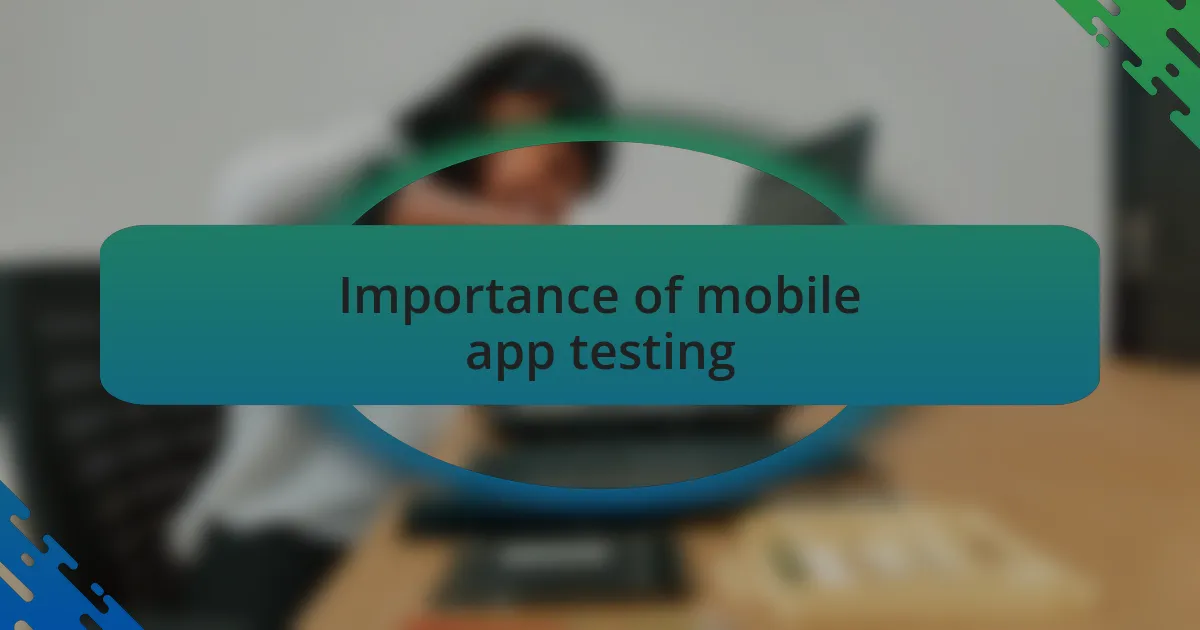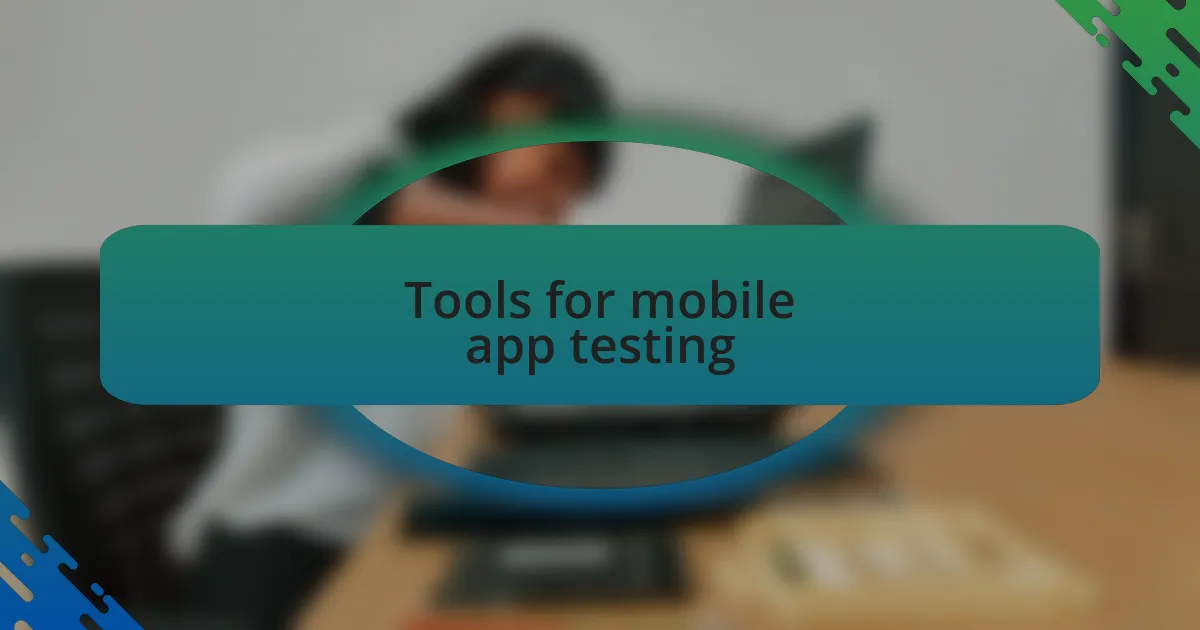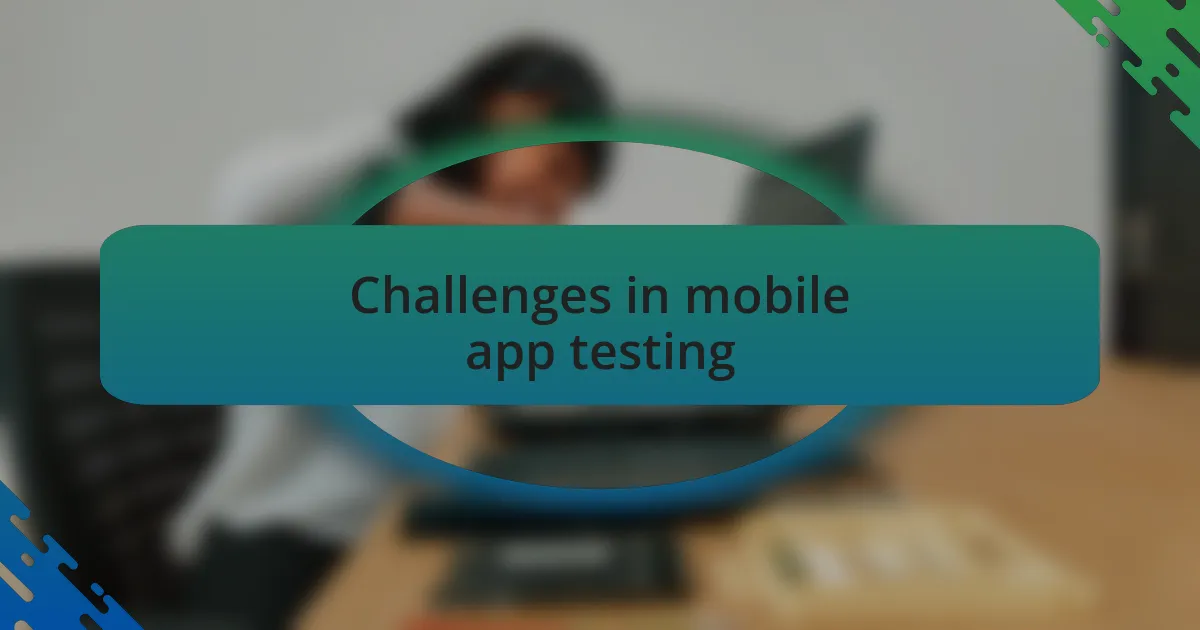Key takeaways:
- Mobile app testing is crucial for ensuring functionality, user satisfaction, and brand image, with a focus on identifying issues before users do.
- Utilizing diverse testing methodologies, including exploratory and automated testing, can uncover hidden problems and improve efficiency.
- Engaging users for feedback during beta testing provides valuable insights that can significantly shape the product’s direction.
- Implementing best practices like test-driven development and prioritizing user experience can transform the testing process and enhance app quality.

Understanding mobile app testing
Mobile app testing is a critical step in ensuring that applications function seamlessly across various devices and platforms. I remember the first time I encountered a frustrating bug in an app I was testing; it made me realize just how important it is to identify issues before users do. Have you ever downloaded an app that looked great but was riddled with problems? That experience highlights the necessity of comprehensive testing.
While functional testing checks if the app behaves as expected, performance testing delves deeper into its responsiveness under load. I’ve seen firsthand how a user’s experience can change drastically based on minor performance issues; a lagging app can turn potential customers away in seconds. Isn’t it fascinating how something as simple as load time can impact user satisfaction so profoundly?
Usability testing, on the other hand, is about understanding the user’s perspective. I always emphasize the importance of empathy in this phase; it’s not just about the app’s functionality but how intuitive it feels to the user. Reflecting on my testing experiences, I’ve learned that understanding a user’s journey can unveil hidden issues and lead to a much better product. What would you feel if an app you loved suddenly became difficult to navigate? That’s the kind of friction we aim to eliminate through effective testing strategies.

Importance of mobile app testing
Mobile app testing is essential because it directly influences user satisfaction and retention. I recall a project where, despite having a fantastic design, we faced numerous crashes during high-traffic times. It was eye-opening to witness user frustration firsthand as they uninstalled the app instead of giving us a second chance. Isn’t it surprising how easily a poorly tested app can tarnish your brand image?
Moreover, security testing must not be overlooked. There was a time when a client skimped on this aspect, and shortly after launch, they experienced a data breach. This event served as a stark reminder of the stakes involved; users trust us with their data, and we have to honor that trust. Can you imagine the fallout from violating that trust?
Every app goes through different life stages, making continual testing crucial. I’ve learned that the app’s performance must be evaluated even after its initial release, as updates can inadvertently introduce new issues. Reflecting on my experiences, I realize that proactive testing ensures the app not only meets current standards but also adapts to user feedback effectively. How often do we revisit our favorite apps to find they’ve improved through diligent testing?

Testing methodologies for mobile apps
Testing methodologies for mobile apps are as diverse as the apps themselves. One approach I find particularly insightful is exploratory testing. In one project, I remember diving into the app without a rigid plan, just letting curiosity guide me. This method uncovered bizarre edge cases that standard testing missed. Have you ever experienced a feature that just didn’t work the way you expected? That’s often due to unforeseen user behavior that exploratory testing can highlight.
Automated testing is another cornerstone of mobile app testing that I swear by. While it’s tempting to think we can cover everything with manual testing, I’ve seen how automated tests can run the same scenarios repeatedly without fatigue. Just a few months ago, during a regression testing phase, we saved so much time by automating previous test cases. It felt like having an extra set of hands that never tires. Is there anything more satisfying than knowing that the basics are covered while you focus on more complex issues?
Let’s not overlook the power of user acceptance testing (UAT). I vividly recall conducting UAT for a social media app alongside some potential users. Their feedback was incredibly valuable, bringing fresh perspectives that shaped our final version. I genuinely believe that involving real users during the testing phase clarifies the direction of the app. After all, who better to validate our work than the very people we’re building it for?

Tools for mobile app testing
When it comes to tools for mobile app testing, I often rely on Appium, which is a game-changer when addressing cross-platform needs. I vividly remember a time when I had to test an application on both iOS and Android. The ability of Appium to use the same codebase across both platforms saved us hours of redundant work. Have you ever felt the frustration of having to repeat tasks that should be automated?
Another tool I frequently use is Firebase Test Lab. It allows us to test across various device configurations effortlessly, which is something I learned the hard way during a project where device fragmentation became a nightmare. The insights we gained from running tests in the lab helped us identify performance bottlenecks that could be easily overlooked in a manual process. Isn’t it reassuring to know that you can unearth such issues before they reach the end user?
Lastly, I can’t forget about tools like TestFlight for beta testing. There was a particular instance when we released a beta version of our app and the feedback flooded in. TestFlight’s seamless integration with the development process not only provided us with insightful user reactions but also made it easy to iterate quickly based on that feedback. Doesn’t having a direct line to your users during testing feel like an invaluable connection?

My personal testing strategy
When it comes to my personal testing strategy, I prioritize both functional and exploratory testing. In one project that had tight deadlines, I remember spontaneously shifting gears to exploratory testing after initial functional tests revealed minimal issues. This allowed me to discover user experience problems that wouldn’t have surfaced through standard testing and reminded me of the importance of thinking like an end user. Isn’t it fascinating how stepping outside the predefined scripts can lead to unexpected insights?
I also place considerable emphasis on automated testing for regression purposes. I recall a specific instance when a new feature was added, and we feared it might break existing functionality. By automating regression tests, we not only saved precious time but also reduced the anxiety of manual re-testing. Have you ever felt that looming dread of manual testing after significant changes? Automation can certainly be a liberating solution!
For my user feedback loop, I integrate feedback sessions post-beta testing to guide future updates. I vividly remember a time when our team met with users who provided real-time thoughts during an interactive session. This experience was eye-opening; the feedback we received went beyond mere bugs—it shaped the app’s direction. Engaging users in this way always reminds me that their perspective is critical, doesn’t it?

Challenges in mobile app testing
When I think about the challenges in mobile app testing, one that immediately comes to mind is the diversity of devices and operating systems. I recall a time when we faced a significant issue with a feature that worked flawlessly on one device but completely failed on another due to subtle differences in screen resolutions and software versions. It felt like an endless game of cat-and-mouse trying to replicate, identify, and resolve those inconsistencies. Have you ever encountered a similar frustration in your testing experience?
Another challenge is the varying network conditions that users may encounter. During one project, I had to test an app that relied heavily on real-time data. I distinctly remember running tests in low-connectivity scenarios, only to discover how poorly the app handled timeouts and slow responses. It begged the question: how can we claim to provide a seamless user experience when many users may not have access to ideal conditions?
Additionally, the speed of updates and fast-paced development cycles can really complicate the testing landscape. There was this one instance where, after we had finalized testing for a release, a last-minute feature was added. I felt my heart sink as I realized we would have to scramble to ensure everything worked seamlessly. It made me think about the balance between speed and quality—how do we maintain both when the pressure is on?

Best practices for effective testing
When it comes to effective mobile app testing, adopting a test-driven development (TDD) approach has been a game-changer for me. I remember a project where we integrated TDD from the start, and it completely transformed our workflow. Instead of finding bugs late in the cycle, we identified them early, and I felt a wave of relief knowing that we were building on a solid foundation.
Another best practice I find invaluable is prioritizing user experience throughout the testing process. During one rigorous testing phase, our team incorporated actual user feedback, which illuminated areas we hadn’t anticipated could cause frustration. It struck me just how essential it is to step into the users’ shoes—after all, if our app doesn’t resonate with them, what’s the point of all our hard work?
Lastly, I cannot emphasize enough the importance of automated testing. In a previous role, I introduced automation tools that streamlined repetitive tasks, allowing our team to focus on more complex scenarios. This shift not only boosted our efficiency but also brought a sense of empowerment—suddenly, we had more time to think creatively about potential user journeys. Isn’t it fascinating how automating mundane tasks can spark innovation?